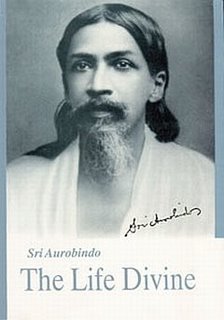 |
The Ascending Series of Substance
From Matter to Spirit
The only substance which we infallibly and concretely perceive in this earth-existence is Matter. This is because the materiality of Matter is implicit in its solidity, tangibility, resistance and durability. But the most important aspect is that Matter can be grasped by senses and this is facilitated by the fact that Matter is perceived through forms. Indeed the “formula of accomplished divisibility” (The Life Divine, pg.267) allows Matter to be subject to the principle of division so that the material form becomes unique in terms of “concentration, resistance, durably gross image, mutual impenetrability –the culminating point of distinction, separation and division”. (Ibid)
(This is why in the Vedas the earth is the symbol of the material principle and touch was the essential basis of sense while the Sankhya classified five elemental states of Substance from ether to earth.)
|
|
But the existence is not made of the materiality of Matter only. It is also made of a graded series of more and more flexible, less and less durable and progressively subtle substance like emotions, thoughts, will-power, soul, Spirit. “This is to say that they must be marked by less and less bondage to the form, more and more subtlety and flexibility of substance and force, more and more interfusion, interpenetration, power of assimilation, power of interchange, power of variation, transmutation, unification”. (Ibid) As we focus on this hierarchy that extends from gross substance to pure spirit substance, the onus shifts from
(a) Durability of form towards eternity of essence ,and
(b) Separation and resistance of physical Matter to divine poise in infinity, unity and indivisibility of Spirit. (Ibid, pg.267-268)
The Chit-Shakti or Conscious-Force aspect of the Highest Reality, Sachchidananda has built the worlds and planes of consciousness. In Matter, the Chit-Shakti condenses itself more and more to resist and stand out against other similar condensations. On the other hand, “in substance of Spirit pure consciousness images itself freely in its sense of itself with an essential indivisibility and a constant unifying interchange as the basic formula even of the most diversifying play of its own Force”. (Ibid, pg.268) Between the two poles of Matter and Spirit rises the possibility of an infinite gradation.
The hierarchy that represents the ascending series of Substance becomes relevant if we consider that a starkly material life is not our ultimate destiny. There are dimensions of life where progressively subtle, non-material factors like arts, music, aesthetics and free thinking dominate over gross material conditions. And there may be the possibility of a Divine life and a divine mind of the perfected human soul who would also want a place under the sun. The obstacle to any dominance of non-material factors finds its acme when it has to reconcile the Divine life with a fundamentally undivine human body –a body full of disharmony and imperfection; a body prone to sensual satisfaction and perversion. Life and mind would require another equation between sense and Substance in other denouements and work out compromises with a little more freer action of sense, life and mind. But at the end our physical existence would still maintain its apocalyptic destiny which the animal body imposes upon the higher principles. “Death, division, mutual resistance and exclusion between embodied masses of the same conscious life-force are the formula of our physical existence; the narrow limitation of the play of our senses, the determination within a small circle of the field, duration and power of the life-workings ,the obscuration, lame movement, broken and bounded functioning of the mind are the yoke which that formula expressed in the animal body has imposed upon the higher principles”. (Ibid)
Sri Aurobindo assures that that the rhythm of the material life does not reveal the full potentialities of cosmic Nature. There are superior states of consciousness, there are higher worlds that represent liberation from the limitations of the sensory apparatus. There may even be here “a physical working of divine mind and sense, a physical working of divine life in the human frame and even the evolution upon earth of something that we may call a divinely human body.” (Ibid)
While we contemplate how to rise to more subtle zones of consciousness that surpass Matter, it is also interesting that there is a trajectory from more to less dense and less to more subtle within the domain of Matter itself. Indeed, we cannot subdivide the subatomic particles, leptons and quarks any further because they seem to lapse into formlessness. This means that we can no longer use the bottoms up model to explain Matter. Where do the subatomic particles lapse? If that zone of formlessness is not a real void or real nullity, it must be some poise of Matter which neither our senses nor our cognition can grasp. What would be the relation between this nebulous Matter and the pure substance of the Spirit, between a perceived nothingness and a luminous, revelatory consciousness? It is not possible to jump from the Inconscience to the absolute plenary consciousness unless there is an intervening medium. “There must be and there are grades between inconscient substance and utterly self-conscious self-extension, as between the principle of Matter and the principle of Spirit”. (Ibid, pg.269)
The ancient revelation in the Taittiriya Upanishad shows how rich is this relation that extends from the matrix of Matter to the boundlessness of the all-pervading Spirit-Self:
“There is a self that is of the essence of Matter – there is another inner self of Life that fills the other – there is another inner self of Mind – there is another inner self of Truth-Knowledge – there is another inner self of Bliss”. (Ibid, pg.266)
Date of Update:
16-May-20
- By Dr. Soumitra Basu
|

